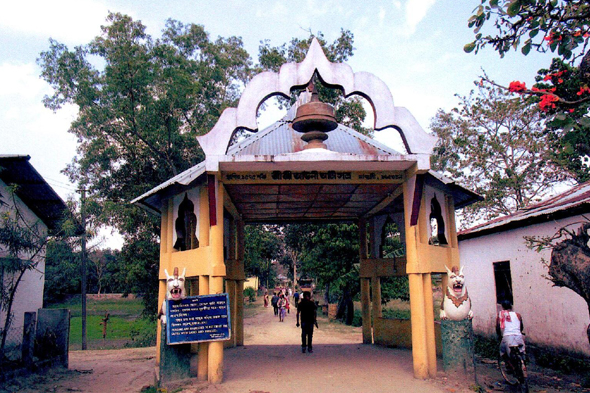Majuli, one of the world’s largest inhabited river islands, has several satras – Vaishnavite monasteries, some dating back to the 16th century. The Institution of Satra is a unique feature of Vaishnavism in Assam, founded by Sankardeva, the father of Assamese culture. The satras are not just monasteries, but centres of traditional performing arts.
In 15th century the first Satra was founded in Majuli. Since then sixty five Satras have come up for the propagation of ethics and socio-cultural ideals. However, at present there are only twenty two Satras in Majuli. The others had to be shifted to safer places due to the devastation of flood and erosion.
The satras consist of a large prayer hall facing a simple shrine, surrounded by dormitories and bathing tanks for monks.
The satras also offer guest accommodation where devotees and visitors not only take part in worship of Vishnu and Krishna,but also watch traditional bhaona performances. Young bhakats – celibates – are wonderful artisans and make masks, musical instruments as well as hand-fans and door frames. Some of the satras worth visiting are Auni-ati, Kamalabari, Dakhinpat, Garamur, Samaguri, Bengena-ati and Natun Kamalabari.
 |  |  |
 |  |  |
Founded by Niranjan Pathakdeva, the Satra is famous for "Paalnaam" and Apsara dances. Also remarkable is it's extensive assortment of ancient artefacts, Assamese old utensils, jewellery and handicrafts.
Founded by Banamalidev, an exponent of Raasleela, which is now observed as one of the main festivals of Assam. During Rasotsava several thousand devotees visit these holy Satras every year.
Founded by Lakshmikantadeva. During the end of Autumn, traditional Raasleela (co-acting) is shown with great enthusiasm. Some ancient weapons called "Bortop" (canons) are preserved here.
Founded by Bedulapadma Ata, it is a centre of art, culture, literature and classical studies. The finest boats on the island are made here. It's branch, Uttar Kamalabari Satra, has showcased the Satria Art in several states of India and abroad.
It is a storehouse of antiques of cultural importance and an advanced centre of performing art. Muraridev, the grand son of Sankardeva's step mother founded this Satra. The royal robes belonging to the Ahom king Swargadeo Gadadhar Singha, is preserved here. Also on display is the royal gold umbrella.
The satra is famous worldwide for it's Mask-making tradition.
The best time to visit Majuli is during the Raas festival in November. Auni-ati, famous for Paalnaam and Apsara dance, has an assortment of ancient Assamese artifacts, utensils, jewellery and handicraft. Dakhinpat is the prime venue for Rasleela while Samaguri is famous for mask-making. At Garamur is preserved medieval weapons such as bartop (cannon). Kamalabari, known for making the best boats, and Bengena-ati are centres of performing arts. Bengena-ati also preserves the royal gold umbrella and gilded robe belonging to Ahom king Swargadeo Gadadhar Singha. The songs and dances initiated by Shri. Sankaradeva , such as Borgeet, Bhatima, Jumora, Chali, Paalnaam, Noyua, Apsara, Satriya Krshna, etc. are taught and promoted here apart from numerous other crafts, of which makmaking is particularly significant.